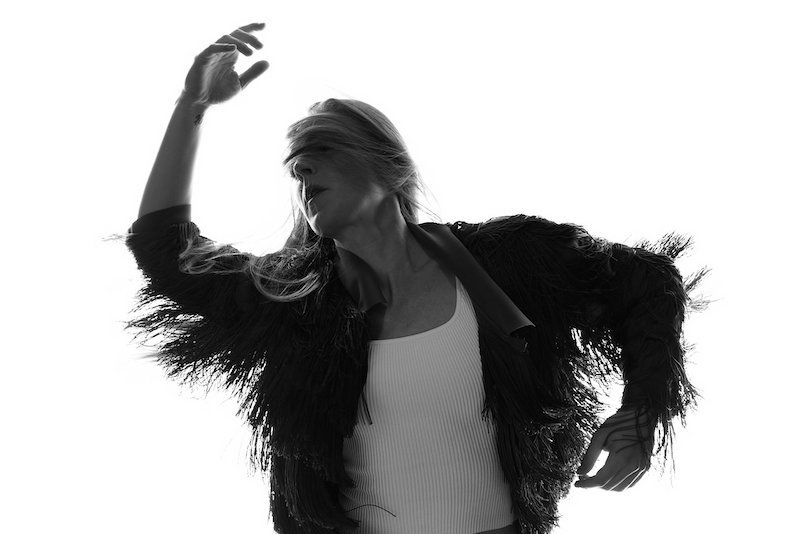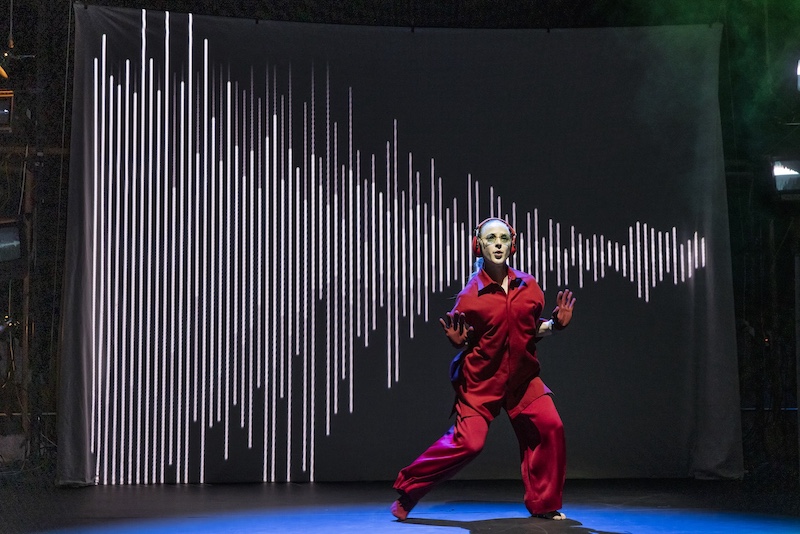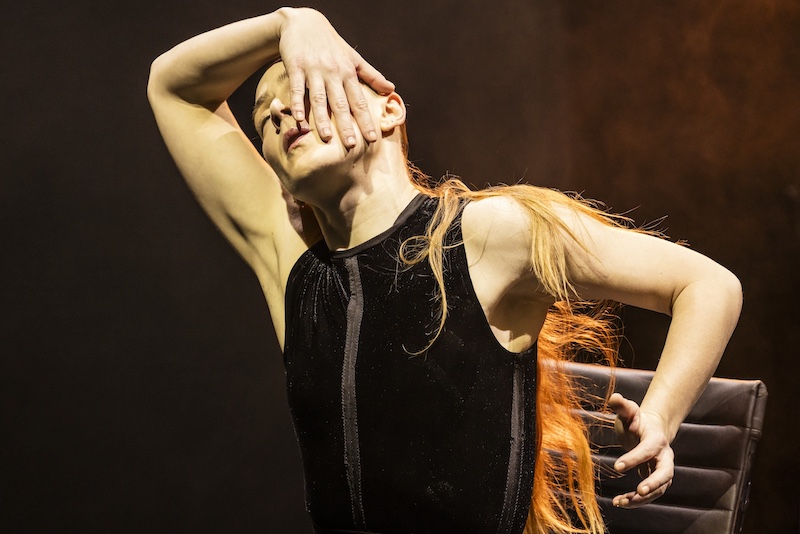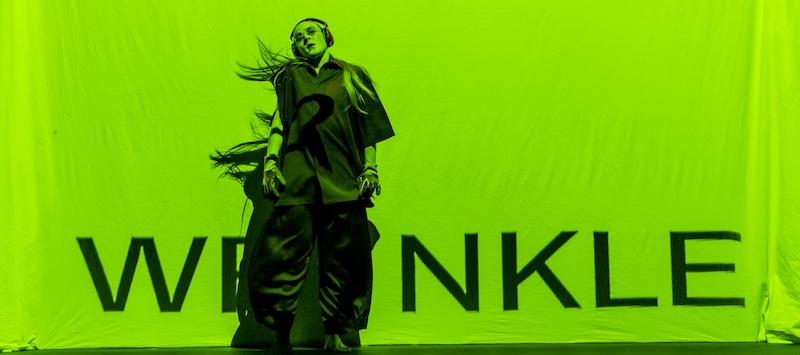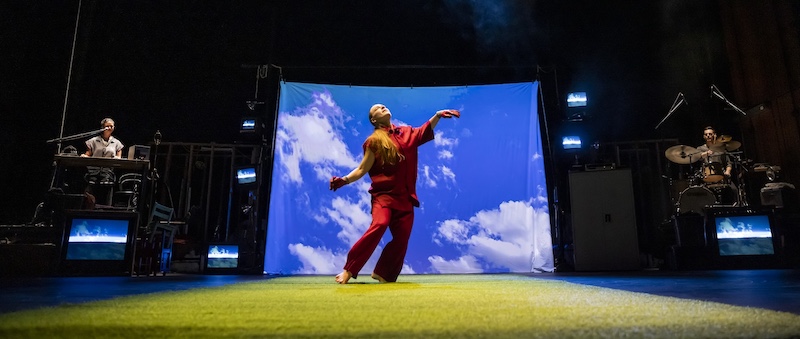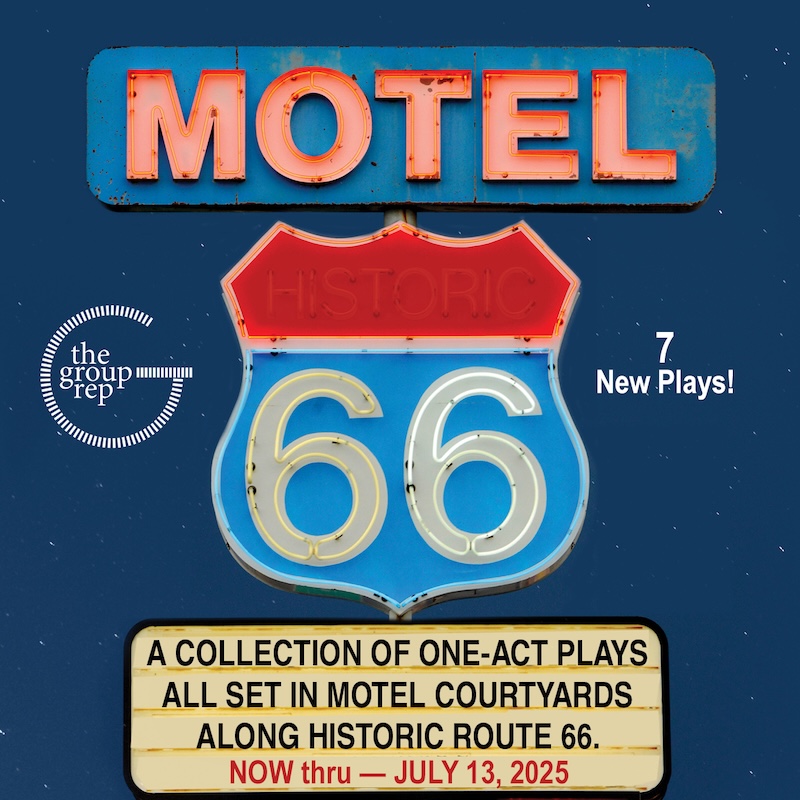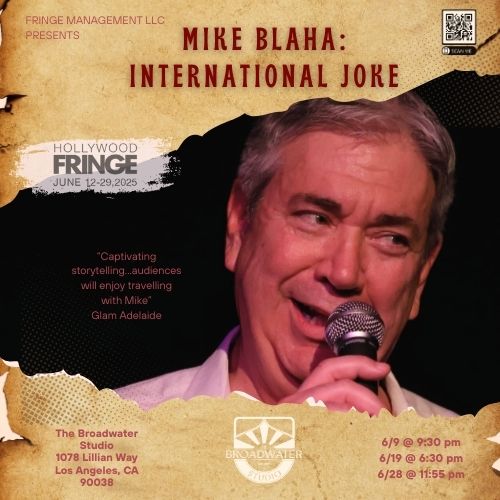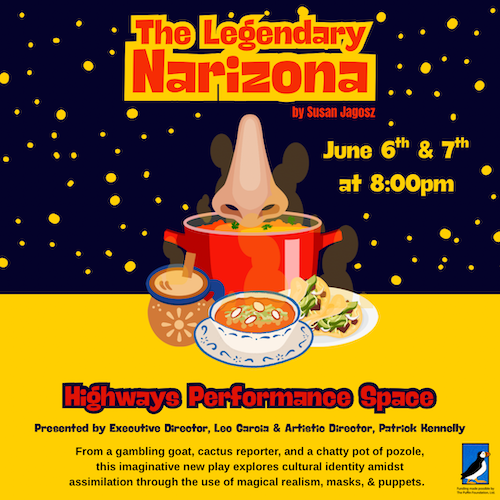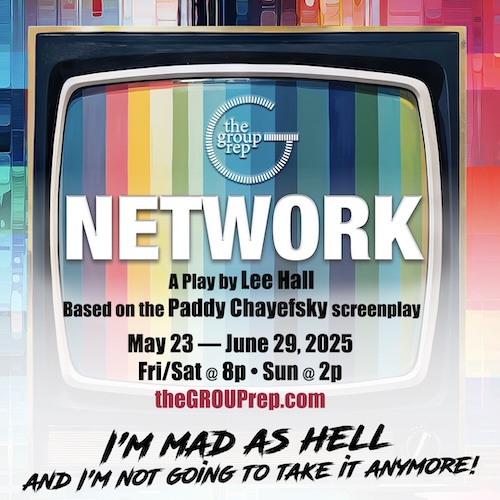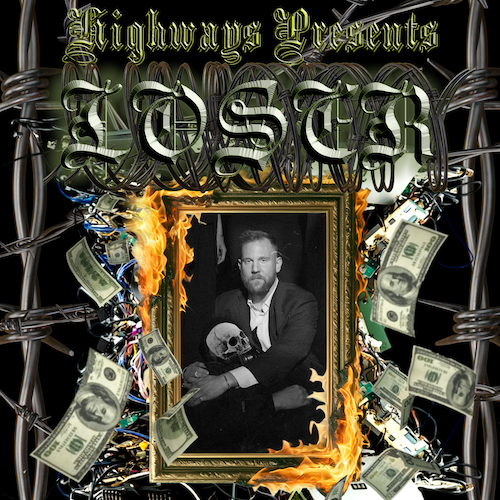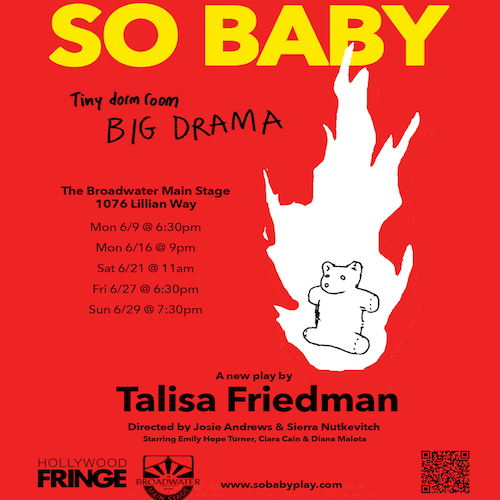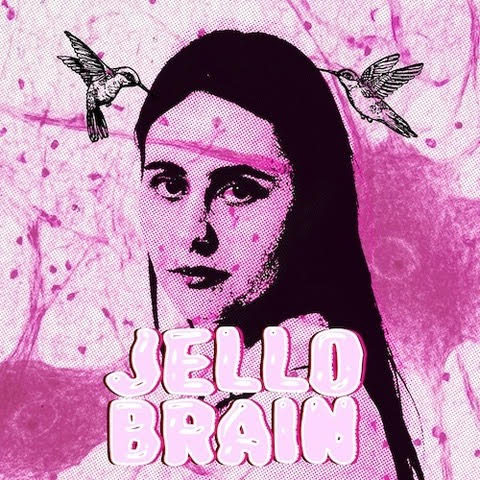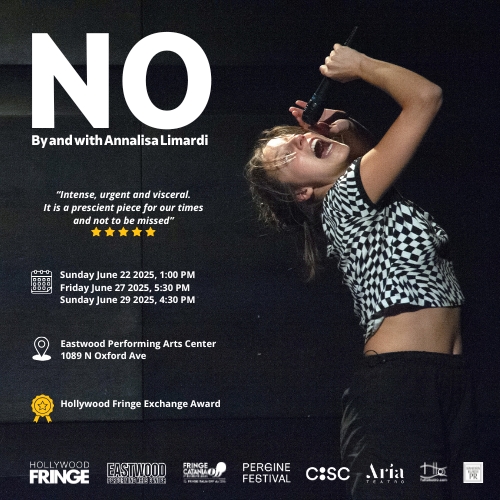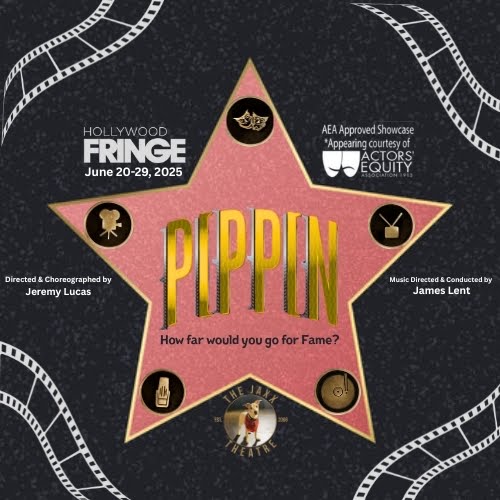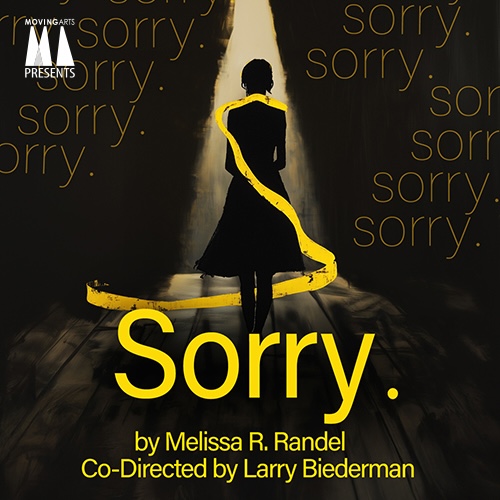
Top photo: Jenn Freeman (photo by Art Davison) All other photos in this article are from the La Jolla Playhouse production of “Is It Thursday Yet?” (Photographer Matthew Murphy)
Autism at the BroadStage
Jenn Freeman, on her dance-theater study in ASD, Is It Thursday Yet?
By Ann Haskins
Note: This article is presented in partnership with L.A. Dance Chronicle
The La Jolla Playhouse has a deserved reputation for incubating new theater but had never ventured into dance, until Is It Thursday Yet? was included in the current season. Directed by Tony-award winner Sonya Tayeh and co-choreographed by Tayeh and Jenn Freeman, the dance-theater work explores Freeman’s personal journey after a diagnosis of autism at age 33.
After its summer performances, La Jolla Playhouse partnered with the Santa Monica’s BroadStage to bring Freeman and her story to Santa Monica for three performances October 3-5.
Narration, video, home movies, and original music tell the exterior story with the diagnosis of her Autism Spectrum Disorder (ASD), while dance evokes the interior story of her feelings and efforts to navigate a puzzling exterior world once armed with a diagnosis that names her tumult.
Freeman took time from rehearsals to speak with Stage Raw’s Ann Haskins about putting her personal story onstage and how her struggles speak to larger issues around autism.
Stage Raw: Why did you decide to do a performance about your diagnosis of autism?
Freeman: Shortly before I had the diagnosis, I had started the very beginning stages of creating a solo piece for myself. I had already asked Sonya to direct that piece. I’ve had a hard time navigating the dance world in general and understanding where I belong in all of it. I had a lot of questions about my life, and I was just really trying to find myself with the solo. So that was already in motion. With the diagnosis, my entire world flipped upside down in amazing ways and scary ways, just a huge perspective and mindset shift for me. Nothing was the same anymore, but Sonya and I were only interested in moving forward from that point. I was learning so much about myself, so much about ASD in general, that it just felt like there was nothing else that the piece could be, besides exploring what was happening. The wheels started spinning and we put it into action.
SR: Was this the first time you used a performance piece like this to process things?
Freeman: I’ve been making deeply personal work and exploring myself through more abstract ideas and making work on other people. What I’m realizing now is, as an autistic person, I tend to be a slower processor, especially emotions and experiences. I’ll make the work from a really instinctual place and pull movement from that place, but I can’t always explain it or talk about it, or even understand what it is. Then later, I can look back on the work and think that piece is sad, and then realize I was sad. I can kind of process that way, but this is the first time I’ve created something this deeply personal and unfolding in real time. When we were making this, nothing had settled. Everything was really raw. Because the epiphany that I was autistic was so much,and I was processing so much, there were days I experienced a large burnout. Those days, even making it into the studio felt impossible, but we still did it. From the beginning, Sonya and I made a process where my needs were considered, not always met perfectly, but considered. A place where I felt safe, something I had never really experienced before as a dancer, as an artist in general.
SR: It sounds like after you created earlier works, you realized emotions you were feeling were reflected in those works. But this one involved feelings that were felt and recognized at the time, intentional, not just to be reflected on after the fact.
Freeman: Yes. Knowing what I know now, I was never able to show up fully as myself inside my work or on stage as a dancer ever, because I was missing this huge piece. I’m not afraid of digging deep or talking about hard things. I was on a quest to understand myself and find the truth, but up until this point, I had never been able to do that. A big part of making this work is I get to be on stage, knowing and understanding who I am as an artist. I haven’t changed as a person, but being able to put language to why I am the way I am, and why I’ve created this movement vocabulary, that is unique to the way I move. The answer is because I’m an autistic person. Having the language changed everything.
SR: Is there language other than just ‘autism’ that names those missing pieces?
Freeman: Yes. Like being able to have conversations like we’re having now and being sure of myself. It is being able to name the experience. So now it is sad in the moment, not later reflecting that I was sad then. I’m getting better at understanding these different sides of myself and why it’s happening now.
SR: Where did the title Is It Thursday Yet? come from?
Freeman: I don’t want to give it away. Oh yes, there’s a punchline. There’s definitely a moment in the show where all of those pieces are put together that you’ll really understand. So the answer is, the title is in the show and from an experience in my childhood. It’s a question that I was asking repeatedly over and over and over again.
SR: You’re a choreographer, and you brought Sonya Tayeh in early to direct. Why did you bring in another choreographer and why Sonya Tayeh?
Freeman: Sonya has become one of my dearest, closest friends and family. We’ve been working together almost 15 years. She’s been my mentor. I’ve been her associate on numerous projects over the years. I’ve danced for her many, many, many times. I trust her. When I’m around her, I feel courageous, and I feel safe. Also, I don’t typically dance in my own work. I like to be on the outside of things when I’m creating them, and I know how difficult it is to do both.
SR: What was the conversation with Sonya when you shared the diagnosis?
Freeman: Sonya was the second person I told after my partner. I went to her house, and we were sitting up on the roof of her building, and I said “Guess what? They finally named it. I’m on the autism spectrum.” She just listened and said she was happy for me. Then she was like, “Now what? What’s possible now that you know this?” I think Sonya is such an authentic truth seeker that even though I was visibly upset and emotional and just processing all of it, she had the perfect perspective to see that as an artist, this was a really valuable piece of information for me. I think I don’t remember exactly what else she said,, I remember just feeling really seen and supported.
SR: How would you describe the flow of the show?
Freeman: It is chapters unfolding. Sonya and I are interested in telling my story, but also there is an educational element of this piece that we wanted to keep intact. When I was diagnosed, I knew nothing about autism. I had never had the thought that maybe I was on the spectrum. It was a completely out of nowhere. And so while I was realizing it, I was also educating myself and learning so much. I just kept having this experience wondering how this was missed? Why more people don’t know these things? I think it is chapters of my coming to know. That part is narrated by my diagnostician, my psychologist. From the day I was diagnosed, all of my therapy sessions were recorded as source material. There is home video footage, and it is all backed by original music composed and performed by Holland Andrews. There is the feel of a lecture demonstration alongside a theatrical narrative and movement-based piece. It alternates between real experiences and past experiences, grabbing these different moments in a life, making sense of the experiences, bringing them together. It doesn’t move linearly, because that wasn’t what the experience was like. It was chaos, holding on to this memory here and that memory there.
SR: Do you find that you dance differently now that you have dealt with the autism diagnosis for three years?
Freeman: I’ve been dancing my whole life, and I am an emotional mover, and that hasn’t changed at all. It is hard to even put language to it. I don’t know if you would look at me and say that I’m different, but as a dancer it is this constant quest to merge your lived experience with your moving body. We move in response to our lives. So if my life is being cracked open, my movement is also being cracked open. That is how it has felt to me. There’s a oneness or a cohesiveness that I’m the one standing there and I’m the one dancing.
SR: The La Jolla Playhouse is not known for dance, although this is more dance/theater, not just dance. How did La Jolla Playhouse become involved?
Freeman: Sonya had worked in La Jolla Playhouse before and they knew her work there and on Broadway. Even though the piece hadn’t been created yet, we were able to articulate what we were making. They believed in what we were making and our message.
SR: Is there anything’s scheduled next, after the performances here in LA?
Freeman: Not right now for the show, but for the last four years, a documentary film has been created about the experience of getting my diagnosis and the creation of the show. That should be coming soon, later this year or early next year,
SR: Do you think dancers are more attuned to when things are not in sync? Are dancers, just more sensitive to that because they’re dancers.
Freeman: In hindsight, now I can see why I became so obsessed with dancing at a young age because it was therapy. A dance class is a magical place where you can go and have what feels like a social experience being in a room full of people, being seen, seeing others moving together, sharing energy, exchanging energy, all without ever having to speak. That was a huge gift for me. I loved that. Also, autistic people tend to be hyper-focused on one thing at a time, and that type of focus is also rewarded in a dance class. My need for repetition, perfection, all of that was rewarded in a dance class. I could go on and on, it was a perfect place for me. I was obsessed with it. I could have lived in the dance studio when I was little.
SR: Was there any other place in your life that offered what you found in a dance class?
Freeman: No. I generally felt completely confused by the entire world that existed outside of the dance studio. Honestly, I still feel that way sometimes. I’m not quite sure how to be elsewhere but I’m learning.
SR: What do you hope the audience takes away?
Freeman: Everyone is different. It’s more about awareness that there are people in the world who have different types of experiences, just remembering that. There is no agenda with this piece. It’s just my story and my experience. Some may see themselves, someone they know, a student, reflect back about someone or some awkward experience, maybe simply learn what autism is, and what one person’s experience was like.
Growing up, I did not see anyone that was like me, sharing an experience like what I was having. That’s a big part of the reason I didn’t know. Representation, in general is obviously so important. For so long, autistic diagnosis was for young, white, cisgendered males. Anyone who existed outside of that demographic was just tossed by the wayside and women, women-identifying, LGBT people were ignored, and anyone not white has a hard time getting diagnosed as autistic.
SR: Now when you encounter people, are there things you can handle now that you couldn’t before?
Freeman: I almost feel like it is the opposite. I’m less willing to withstand things. I recognize the struggle and why it is happening. I’m standing up for myself much more. I’ve been enduring uncomfortable situations for my entire existence. I’m losing the ability to tolerate being uncomfortable. That’s why language and naming experiences is so important. The puzzle piece used to be a symbol for autism. There’s a missing piece of the puzzle is an idea I hear a lot when people are describing autism. For me, I wasn’t missing pieces of the puzzle, the pieces were there, the puzzle just wasn’t put together yet. And that is an important distinction to make. I’m not missing pieces. I’m just still putting the puzzle together.
Is it Thursday Yet? will be presented at The BroadStage, 1310 11th St., Santa Monica, Thurs.-Sat., Oct. 3-5, 7:30 pm. https://broadstage.org/

